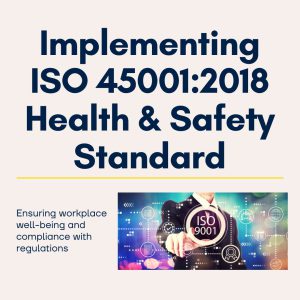ISO 45001:2018

Over 7600 people die each day from work- related accidents or diseases – that’s over 2.78 million every year. To combat the 2.78 million every year. To combat the problem, ISO has developed a new standard, ISO 45001, Occupational health and safety management systems – Requirements, that will help organizations reduce this burden by providing a framework to improve employee safety, reduce workplace risks and create better, safer working conditions, all over the world. As part of Tata Group Star Rating Program we are helping many organization develop and implement this system.
Why get ISO 45001:2018 Certified?
ISO 45001:2018 is the international standard for Occupational Health and Safety (OHS) management systems. Here are the key reasons why organizations pursue this certification:
Improved Workplace Safety: ISO 45001 helps create a framework for identifying and mitigating workplace hazards, reducing the risk of accidents, injuries, and illnesses.
Regulatory Compliance: It ensures that organizations comply with local and international occupational health and safety regulations, reducing legal risks and potential fines.
Reduction in Workplace Incidents: By adopting a proactive approach to risk management, ISO 45001 helps reduce the number of workplace incidents and improves overall safety performance.
Enhanced Employee Morale and Engagement: Certification shows a commitment to the well-being of employees, improving their morale, job satisfaction, and productivity.
Reduced Insurance Costs: Fewer accidents and incidents can lead to lower insurance premiums, reducing costs for the organization.
Improved Risk Management: The standard emphasizes proactive identification and mitigation of potential safety risks, enabling better long-term planning.
Increased Business Opportunities: ISO 45001 certification is often required for tenders and contracts, especially in industries like construction, manufacturing, and oil and gas.
Positive Reputation: Certification demonstrates that an organization values employee safety, enhancing its reputation with clients, employees, and other stakeholders.
Steps to ISO 45001:2018 Certification
Familiarization and Commitment:
- Understand the ISO 45001:2018 standard by reviewing its requirements and guidelines.
- Gain commitment from top management to implement an Occupational Health and Safety Management System (OHSMS).
Initial Gap Analysis:
- Perform a gap analysis to assess the current state of your organization’s health and safety practices against ISO 45001 requirements.
- Identify areas of improvement and create an action plan to close the gaps.
Training and Awareness:
- Provide training to employees and key personnel on the importance of workplace health and safety, as well as ISO 45001 requirements.
- Raise awareness about the changes required and how the OHSMS will benefit the organization.
Define Scope and Objectives:
- Define the scope of your OHSMS, including the boundaries and applicability of the system to your organization.
- Set measurable health and safety objectives and targets.
Develop and Document the OHSMS:
- Establish the necessary documentation, including health and safety policies, objectives, risk assessments, emergency procedures, and operational controls.
- Document processes for hazard identification, risk assessment, incident reporting, and corrective actions.
Implementation:
- Implement the OHSMS across your organization, ensuring that employees follow the new safety processes and procedures.
- Communicate roles and responsibilities, and ensure that risk management measures are actively applied.
Internal Audits:
- Conduct internal audits to verify the effectiveness of the OHSMS and identify any non-conformities.
- Take corrective actions where needed and continually improve the system.
Management Review:
- Perform a management review of the OHSMS to evaluate its effectiveness, ensure objectives are being met, and identify areas for further improvement.
- Document the outcomes of the review and any changes to policies or procedures.
Pre-certification Audit:
- Engage with an accredited certification body to conduct a pre-certification audit.
- This includes a two-stage process:
- Stage 1 Audit: Review of documentation and readiness assessment for the final audit.
- Stage 2 Audit: A comprehensive on-site audit to confirm compliance with ISO 45001:2018 requirements.
Certification and Continuous Improvement:
- Once the organization passes the certification audit, it will receive the ISO 45001:2018 certification.
- Certification is valid for three years, during which surveillance audits will be conducted periodically to ensure ongoing compliance with the standard.
